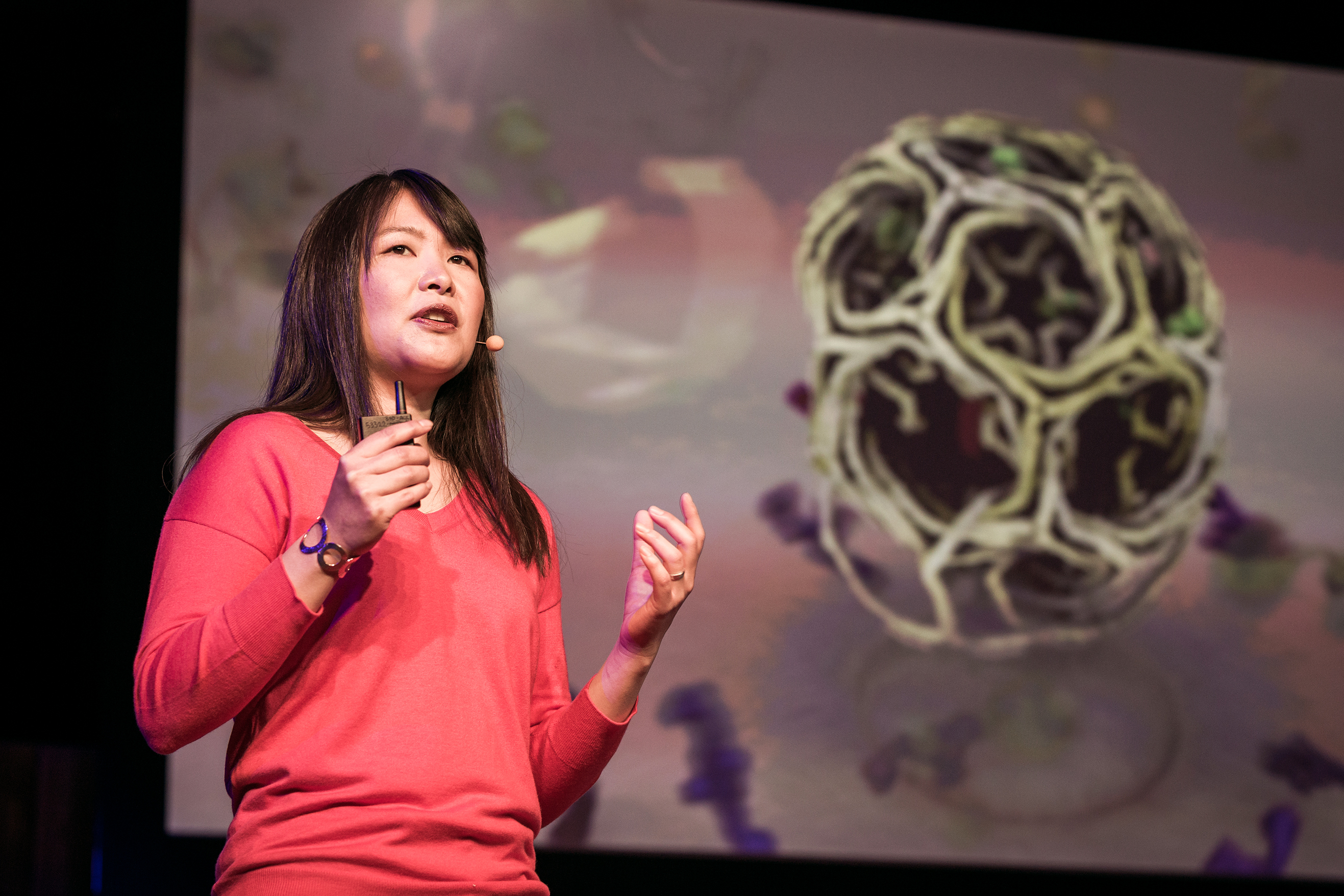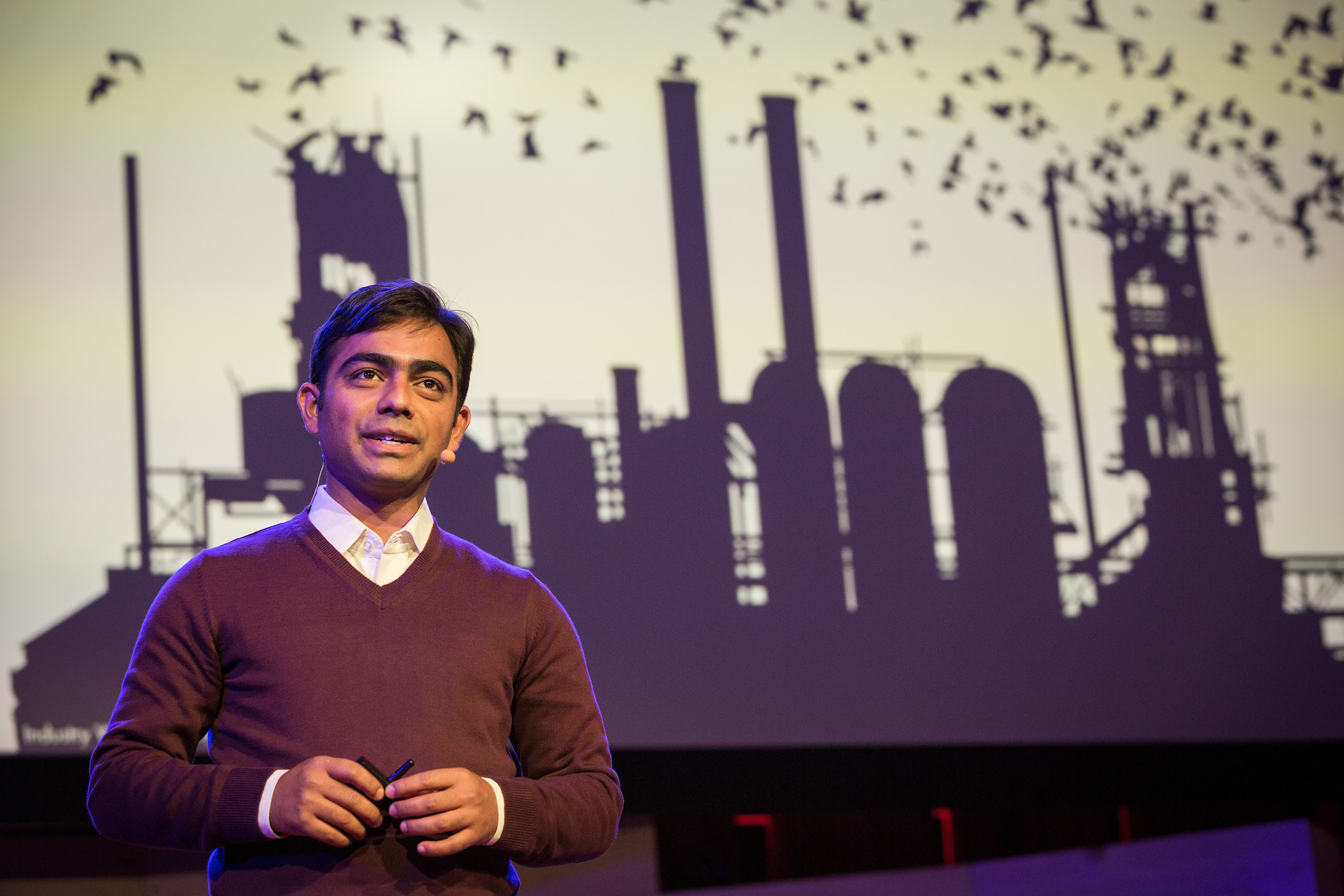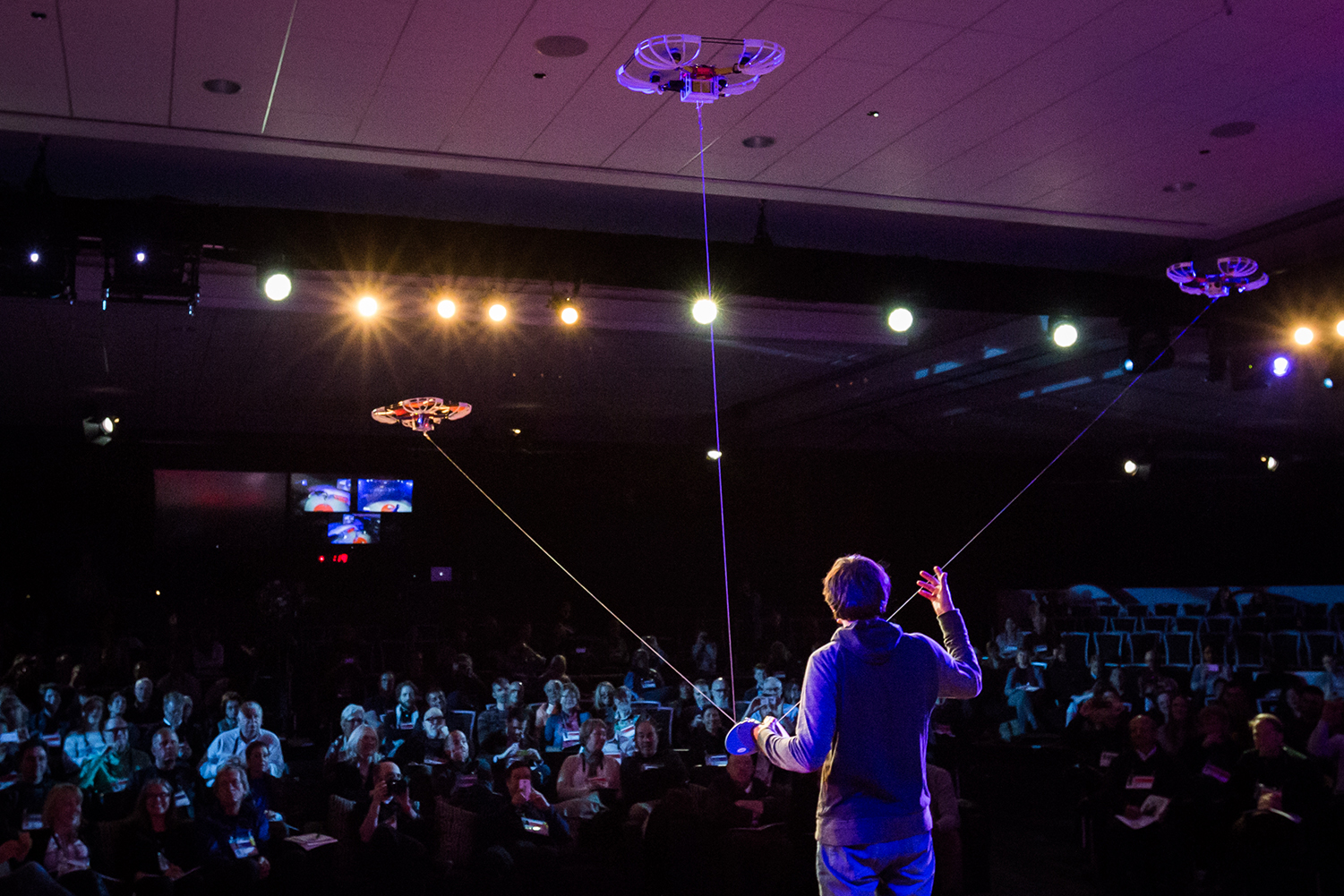With the TED Fellows, expect the unexpected: 3D animated molecules, tethered quadcopter cameras, death row inmates turned lawyers, quantum chaos. It’s the fifth-anniversary edition of TED Fellows talks, live from Vancouver, and here’s what happened in Session 1.
Usman Riaz, musician + artist
The Fellows stage comes to life quietly with the melodic strains of Pakistani composer Usman Riaz’s guitar. The piece, called “Boneshaker,” accelerates into one of his signature percussive pieces. Hammering on strings with his fingers and knocking on the body of the guitar with his knuckles, the piece crescendoes and crashes. The 23-year-old multi-instrumentalist from Karachi is also a composer, filmmaker and visual artist.
Ziyah Gafic, photographer + storyteller
Ziyah Gafic photographs simple, everyday objects: books, keys, shoes, combs, glasses. But these mundane items tell a violent story. Exhumed from mass graves 20 years after the Bosnian War of the 1990s, these objects belonged to the victims of genocide, and are cleaned, catalogued and used to help identify the bodies found with them. Afterwards, they become what Gafic calls “orphans of the narrative,” either destroyed or stored away out of sight and out of mind. His quest is to keep them in view as a last testament to the fact that these people existed, preserving them as an easily accessible visual archive that tells the story of what happened — integrating an objective forensic perspective with human compassion.
Alexander McLean, African prison activist
With quiet intensity, British lawyer Alexander McLean tells the tale of Susan, a female prisoner living in a 7-by-9-foot cell, whom he met while volunteering in a Ugandan prison. Women and girls are particularly vulnerable when they come into conflict with the law, says McLean, often suffering torture and rape at the hands of interrogators and punished for crimes committed by their husbands. Susan, for example, was sentenced to hang for killing her husband when he tried to attack her with a machete. To help people like Susan, McLean founded the African Prisons Project, an organization that offers prisoners a legal education via distance learning so they can defend themselves in court, help empower fellow prisoners, and pave the way for a promising future. Susan finished her degree, spoke for herself in court and had her death sentence overturned. She opened a legal aid program in her prison, and will practice law upon release. This year, the project will launch a class of female inmates from Uganda and Kenya, establishing a new generation of prisoners-turned-lawyers, proving that one’s future need not be determined by one’s past.
Dan Visconti, composer + concert presenter
Dan Visconti wants to update the image of the composer from an old man in a wig with a quill pen to a figure deeply integrated and in service to his or her community. Growing up listening to pop but trained as a classical violinist, Visconti creates vibrant new ways to present classical music, letting it serve as a locus for engaging in social issues. One recent project, a work commissioned by CityMusic Cleveland, was a weeklong musical event based on the experiences of the city’s 30,000 refugees — including musicians and dancers from refugees’ home nations. This project gave voice to typically sidelined communities, helped young kids learn about their own cultural histories, connected the city’s refugee groups, and helped identify and empower community leaders. With this kind of public engagement, Visconti is embodying a new classical composer’s role for the 21st century.
Aziza Chaouni, architect + ecotourism specialist
The river that runs through the ancient Medina in Aziza Chaouni’s hometown of Fez was once considered its soul, sending water to both public and private fountains throughout the city. But since the 1950s, overcrowding, over-development and pollution from such industries as tanning turned the stream into a toxic sewer. The city responded by covering the river over with concrete slabs, in the process destroying houses and creating dumping grounds. When Fez received a grant to divert and clean the water, Chaouni proposed the Fez River Project to uncover and restore the riverbanks, create pedestrian pathways, reclaiming these areas as public spaces and reconnecting them to the rest of the city. Over the course of years, the river is gradually being uncovered, illegal parking lots are being transformed into playgrounds, trees and other vegetation are being planted, revitalizing Fez as a living city.
Shubhendu Sharma, reforestation expert
Industrial engineer Shubhendu Sharma was working at Toyota in India when he met Japanese forest expert Akira Miyawaki, who’d arrived to plant a forest at the factory, using a methodology he’d developed to make a forest grow ten times faster than normal. Fascinated, Sharma interned with Miyawaki, and grew his first successful forest on a small plot behind a house. Today, his company Afforest promotes a standardized method for seeding dense, fast-growing, native forests in barren lands, using his car-manufacturing acumen to create a system allowing a multilayer forest of 300 trees to grow on an area as small as the parking spaces of six cars — for less than the price of an iPhone. Afforest has helped grow forests at homes, schools and factories. He’s seen improvement in air quality, an increase in biodiversity — and the forests even generate fresh fruit. Afforest is at work on a platform that will offer hardware probes to analyze soil quality — allowing the company to offer step-by-step instructions for anyone who wants to grow a native forest anywhere in the world.
Bora Yoon, composer + sound architect
The soundscape that Korean-American vocalist, multi-instrumentalist and composer Bora Yoon makes is wholly unexpected. As she plucks at a viola’s strings, single notes echo through the air, over which she sings a wordless melody in a voice that seems detached from Earth, swaying in a swooning dance while weaving an undulating web of sound. “Both music and architecture are systems that organize empty air,” says Bora Yoon, who later retakes the stage to talk about the ideas behind her immersive and experiential sonic pieces. Yoon often seeks out interesting historical buildings in which to work, often walking into a space and asking, “What does this room want to say? What instruments can I use from different eras that can give this room voice?” She sees music “as colored wind, which fills the room with different textures and hues.” But it’s not only about external spaces: her new album, Sunken Cathedral, uses music to illuminate and explore internal architecture, too. “What might the body sound like within,” she asks. “What stories are caught up in muscle memory, our blood identity?” Finally, she wonders, “What if we can see ourselves as a collective synaptical body?” Music is vital to keeping that body healthy and alive.
Aziz Abu Sarah, tourism entrepreneur + educator
When Aziz Abu Sarah was a boy, his older brother was arrested on charges of throwing stones. He was taken to prison and beaten — and died of his injuries. Sarah grew up angry, bitter and wanting revenge. But when later in life he met, for the first time, Jews who were not soldiers, Sarah had an epiphany: not only did these people share his love of small things, namely country music, but coming face to face with the “enemy” compelled him to find ways to overcome hatred, anger and fear. He founded MEJDI Tours to send tourists to Jerusalem with two guides, one Jewish and one Palestinian, each offering a different history and narrative of the city. Sarah tells success stories of tourists from US visiting a Palestinian refugee camp, listening to joint Arab and Jewish bands playing music; and of a Muslim family from the UK sharing Sabbath dinner with a Jewish family and realizing that 100 years ago, their people came from the same town in Northern Africa. MEJDI is expanding its service to Iran, Turkey, Ireland and other regions suffering from cultural conflict. If more of the world’s 1 billion tourists were to engage with real people living real lives, argues Sarah, it would be a powerful force for shattering sterotypes, promote understanding, friendship and peace.
Jorge Mañes Rubio, conceptual artist
A perpetual tourist, Jorge Mañes Rubio creates artworks that reimagine and remember places from all over the world that would otherwise be forgotten. In 2013, he visited the Three Gorges Dam, a project to transform part of the Yangtze River into a giant reservoir that has forced 4 million people so far to relocate. There, he discovered abandoned cities that had no name, and entire villages lost under water. In commemoration, he created souvenirs — imagine a map of forgotten cities, dotted with jerry cans filled with water from the reservoir and decorated with traditional Chinese motifs. Another project celebrates the island of Nauru, the world’s smallest island state and once a tropical paradise that became the second richest country in the world due to its abundance of natural resources — phosphates from guano and limestone. Today, due to overexploitation, the island is an abandoned desert, its vegetation stripped away. Rubio redesigned an imaginary national flag for Nauru, featuring a bird dropping guano — a playful proposal for a more sustainable future for the island.
Erine Gray, software developer
When Erine Gray’s mother contracted encephalitis and suddenly required full-time care, her family struggled, but rallied. Through this experience, Gray realized that crisis will strike most of us at some point — whether it’s getting cancer, losing a job or facing eviction. In the United States, only basic needs are met by the government. Many good social service safety nets exist, but 95% are provided by unconnected religious or charity organizations and NGOs, and finding the right service can be bewildering. In 2010, Gray created Aunt Bertha, a simple, friendly and fast way to find services online. Just by entering a zip code, users can start browsing local social services — everything from food banks to mental health care to housing assistance and more — while typing in income level helps identify what services they qualify for. Since the service launched, many people have shared stories — none looking for a handout, but just needing a break. “If you’re in a bind, Aunt Bertha can help point in the right direction.”
Janet Iwasa, molecular animator
While we know a lot about molecular processes, they can’t be observed directly, and scientists have to rely on simple, two-dimensional drawings to depict complex hypotheses. That is, they did until now. Janet Iwasa’s colorful and action-packed 3D animations bring scientific hypotheses to life, showing how we think molecules look, move and interact. Not only is molecular animation a powerful way to illustrate ideas and convey information to general audiences, it’s also a powerful tools for inspiring new research. However, 3D molecular animation using commercial software requires skill and time, so Iwasa has created a simpler 3D animation software tool for biologists, allowing researchers to intuitively and quickly model molecular hypotheses. Today, she is launching the beta of her new free, open-source animation software, Molecular Flipbook, which allows biologists to create molecular animations of their own hypotheses in just 15 minutes.
Robert Simpson, astronomer + web developer
Instead of playing Angry Birds, why not use the time to do something awesome for science? Robert Simpson’s online platform Zooniverse crowdsources help with scientific research, asking citizen scientists from all over the world to work on projects across a variety of disciplines. In Snapshot Serengeti, volunteers tag species and activities in photographs of wildlife. With Cell Slider, contributors help facilitate breast cancer research by identifying patterns and colors in research data. And in Galaxy Zoo, citizens help classify galaxies by identifying shapes. Sharp-eyed volunteers even helped identify a galaxy that had not yet been discovered by scientists — demonstrating that sometimes it takes many human eyes to hasten the discovery of something new.
Shohini Ghose, quantum physicist + educator
Shohini Ghose investigates what unpredictability looks like at the quantum level. Small changes in predictable systems can lead to huge consequences — a phenomenon known as the butterfly effect in chaos theory. But in the world of the single atom, governed by the laws of quantum physics, unpredictability is different. Until recently, scientists have not been able to observe atoms directly, but when a laser beam is directed into a cloud of atoms, they interact with the light, leaving a footprint of their movements. Ghose took pictures of this interaction, creating films that show, for the first time ever, atoms in a quantum dance, making the invisible visible. Observing this quantum butterfly effect allows scientists to learn more about connections between particles. This will contribute to possible future technologies such as high-speed computing, precision imaging, searches through big data, teleportation and beyond.
Sergei Lupashin, aerial robotics researcher + entrepreneur
When Sergei Lupashin saw how an aerial photograph of massive protests around the 2011 Russian federal elections changed the media silence around the subject, the aerial robotics engineer realized the truth-telling value of the bird’s-eye view. Yet aerial photographs, even those taken by unmanned aerial vehicles, are tricky to produce: it’s difficult to pilot a UAV safely, and government regulations restrict their use. Lupashin gets around both obstacles with his new invention, the Fotokite — a lightweight, camera-equipped quadricopter controlled with a tether (for the purposes of this demo, a dog leash). He turns one on, points it in a direction, and it flies out, hovering at a consistent angle. Then he launches a second, and a third. While the Fotokite would have a huge impact on journalism, it should also prove useful for archeologists, architects, wildlife biologists, emergency responders and more. The possibilities are endless. If you had one, Lupashin asks, what would you do with it?
Lars Jan, transmedia director
In 2010, floods devastated Pakistan. Lars Jan remembers being riveted by a news photograph of half-submerged figures fighting the overwhelming power of the water, desperately trying to salvage relief supplies dropped by helicopter. In response, he conceived of HOLOSCENES to explore the human relationship with water. This large-scale performance installation, now in development, comprises three aquarium-like structures sited in public spaces. The aquariums are filled and drained with a custom hydraulic system, profoundly affecting the movements of the performers within, who are acting out such everyday behaviors as a woman buying flowers in Saudi Arabia or making ramen in a Japanese dorm kitchen. As the water rises, the performer swims, resuming activity as the water drains — choreographing into an uneasy dance that comments on the relationship between nature’s forces and the quotidian detail of human life.
Usman Riaz + Susie Ibarra, percussionist, composer + educator
Usman Riaz returns to the stage joined by Susie Ibarra to perform a duet — a piece combining and layering two original compositions by the artists: Riaz’s “Shimmer” and “Moon Over Still Water of a Lost Road” by Ibarra.



Comments (3)
Pingback: TED2014: Sergei Lupashin’s aerial view | TEDFellows Blog
Pingback: From an eye exam on your phone to bioluminescent sculpture that looks alive: A recap of the TED2014 Fellows Talks, Session 2 | TEDFellows Blog
Pingback: “Change the world one eye at a time”: Audience responses to the TED2014 Fellows talks | TEDFellows Blog